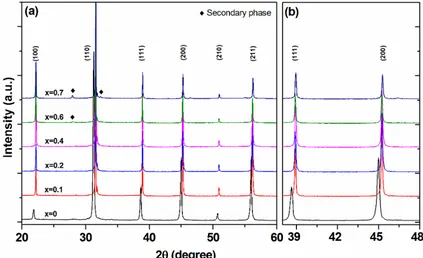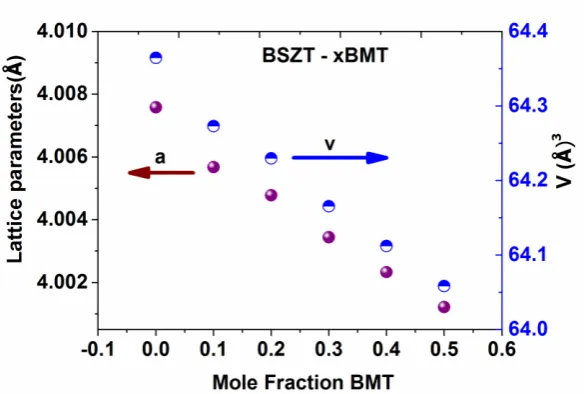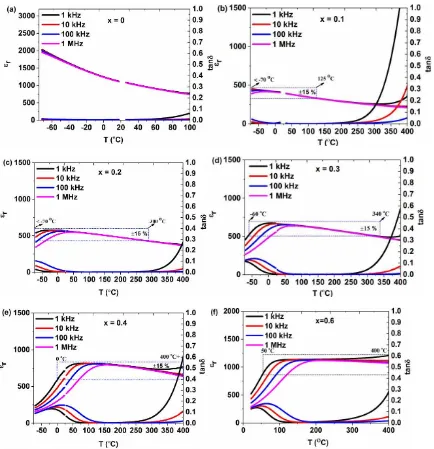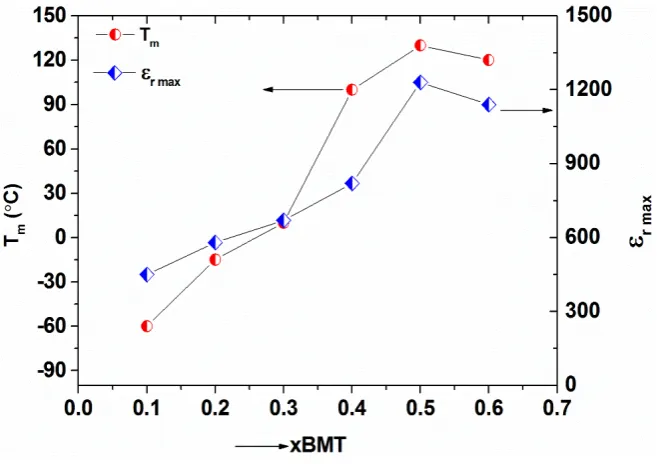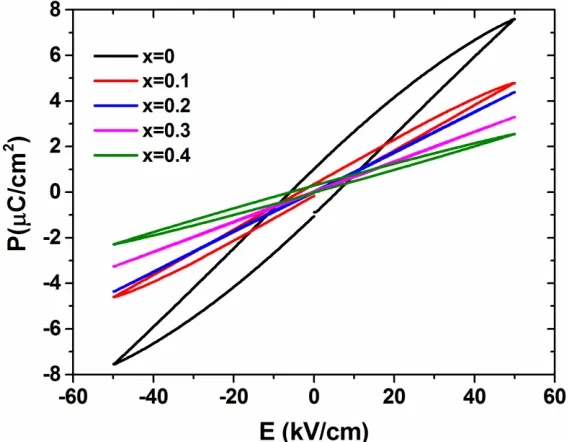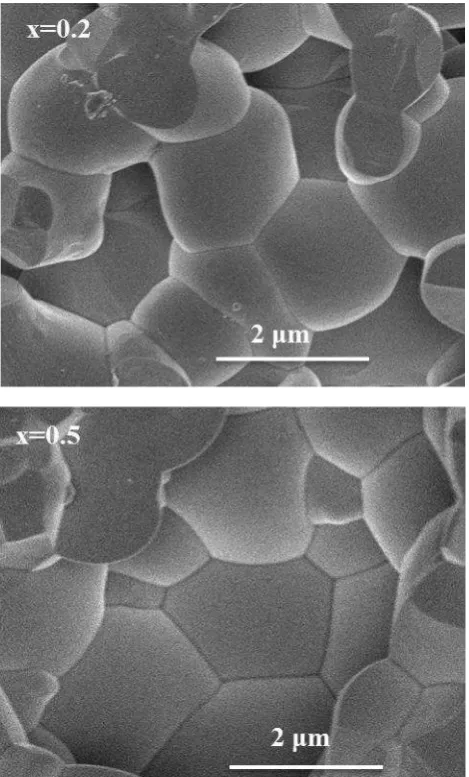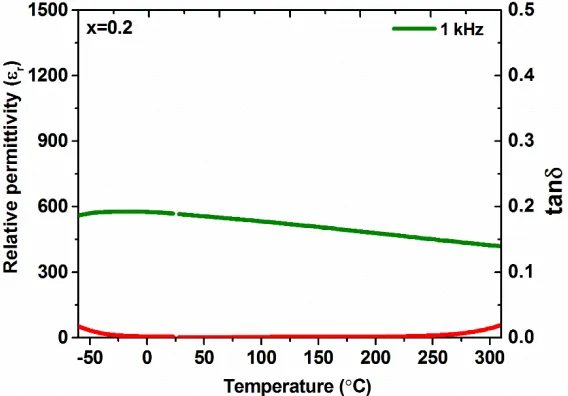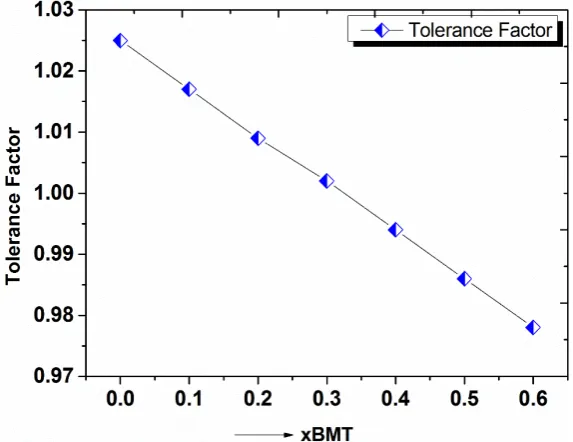from −60 to 300 °C: A potential high temperature capacitor material.
White Rose Research Online URL for this paper: http://eprints.whiterose.ac.uk/99159/
Article:
Jan, SU, Zeb, A and Milne, SJ (2016) Dielectric ceramic with stable relative permittivity and low loss from −60 to 300 °C: A potential high temperature capacitor material. Journal of the European Ceramic Society, 36 (11). pp. 2713-2718. ISSN 0955-2219
https://doi.org/10.1016/j.jeurceramsoc.2016.03.018
© 2016. This manuscript version is made available under the CC-BY-NC-ND 4.0 license http://creativecommons.org/licenses/by-nc-nd/4.0/
eprints@whiterose.ac.uk https://eprints.whiterose.ac.uk/
Reuse
See Attached
Takedown
If you consider content in White Rose Research Online to be in breach of UK law, please notify us by
Dielectric ceramic with stable relative permittivity and low loss from -60 to 300 ºC: a potential high temperature capacitor material
Saeed Ullah Jan, Aurang Zeb and Steven J. Milne
Institute for Materials Research, School of Chemical and Process Engineering, University of Leeds, Leeds, LS2 9JT, UK
Saeed Ullah Jan janicup@gmail.com
Aurang Zeb zebicp@gmail.com
Dielectric ceramic with stable relative permittivity and low loss from -60 to 300 ºC: a potential high temperature capacitor material
Saeed Ullah Jan, Aurang Zeb and Steven J. Milne
Institute for Materials Research, School of Chemical and Process Engineering, University of Leeds, Leeds, LS2 9JT, UKA
Abstract
A new dielectric is described that meets the industry-standard lower limiting temperature of stable performance, -55 °C whilst extending the upper limit to 300 °C, with low dielectric loss, as required for the developing high-temperature electronics sector. The combined substitution of Sr and Bi ions on A sites, and Mg and Zr ions on B sites of the ABO3 perovskite solid solution
(1-x)Ba0.6Sr0.4Zr0.2Ti0.8O3-xBi(Mg0.5Ti0.5)O3, flattens the r -T response. At composition x = 0.2 the rmax temperature , and the associated tan dispersion peak, are each displaced to low temperatures
such that a very favourable combination of low dielectric loss, tan < 0.015, from -60 to 310 °C and stable r, ~ 500 ± 15 % from -70 to 300 °C (1 kHz data) is demonstrated. The x = 0.2 material
achieves stable r and low loss over the technologically important target temperature range, -55 to
300 °C.
Introduction
There is growing interest in developing high-temperature, high relative permittivity dielectric ceramics (lead-free) for Class II capacitors in electronic systems that can operate at elevated temperatures, well beyond 200 ºC [1, 2]. Conventional barium titanate ferroelectric based capacitors retain stable relative permittivity, r, within ±15 % from a lower operating temperature
limit of -55 ºC to upper temperatures of 125 – 175 ºC (as specified by the Electronic Industries Alliance for X7R – X9R type Class II capacitor materials). In recent years, alternative perovskite ceramics, based on relaxor dielectrics have shown promising r temperature-stability to much
higher temperatures than X7R – X9R.
The r–T response of these temperature-stable relaxors differs substantially from that of a
normal relaxor, such as Pb(Mg1/3Nb2/3)O3, in that the normal broad r(T) relaxor peak (at
temperature Tm) is supressed, to give a plateau with only a slight variation in r (within ± 15 %)
across a broad temperature range. The materials are compositionally modified perovskites, ABO3
which incorporate Bi3+ on A-sites [3- 20] as reviewed in reference [21], for example (1–x)BaTiO3
– xBi(Mg0.5Ti0.5)O3 solid solutions [3-7]. The level of stability in r(T) for (1–x)BaTiO3 –
xBi(Mg0.5Ti0.5)O3 becomes more pronounced with additional Ca2+ substitution, giving r values ~
1000 ± 15 % (1 kHz) from 80 – 500 °C [3].
One possible reason for the change from normal to temperature-stable relaxor behaviour is that the increases in size and coupling of polar nanoregions on cooling below the Burn’s temperature, TB that create a distinctive, broad r-T peak in a normal relaxor are inhibited in heavily substituted
perovskite relaxors which invariably involve Bi ion substitution. However the mechanisms underpinng temperature-stable relaxors are uncertain. In most reports of novel high temperature dielectrics, the lower temperature limit of stable r(T) is generally above room
(Ba,Ca)TiO3 – Bi(Mg0.5Ti0.5)O3 – NaNbO3 [BCT – BMT – NN], with r ~ 600 ± 15 % from ~ -70
°C to 300 °C and tan ≤ 0.02 from -60 °C to 300 °C [1, 8]. Other examples include: (1– x)[0.94Na0.5Bi0.5TiO3 – 0.06BaTiO3] – xCaZrO3, with r ~ 470 ± 15 % from ~ -40 °C to 450 °C,
but in this case the estimated range of tan ≤ 0.02 (as required for many devices) is restricted to the temperature range +50 °C to 200 °C (estimated) [2, 20]; (1–x)[0.82(0.94Na0.5Bi0.5TiO3 –
0.06BaTiO3) – 0.18K0.5Na0.5NbO3] – 0.2CaZrO3,with r ~ 400 ± 15 % from ~ -30 °C to 400 °C,
and tan ≤ 0.02 from 20 °C to 180 °C (estimated) [20]; and the system BaTiO3 – Na0.5Bi0.5TiO3
– Nb2O5, with r ~ 2404 ± 13 % from ~ -55 °C to 375 °C, but only room-temperature tan data
were reported [19].
Here we have examine the effects of Sr (A-site) and Zr (B-site) modifications to a BaTiO3
end-member: focussing on the composition, Ba0.6Sr0.4Zr0.2Ti0.8O3. These substituents are known to
reduce the Curie point temperature in the parent BaTiO3 ceramic. Further compositional
modifications were achieved by exploring solid solutions along the compositional join (1-x)Ba0.6Sr0.4Zr0.2Ti0.8O3- xBi(Mg0.5Ti0.5)O3, creating additional Bi3+ ion substitution on A-sites and
Mg2+ on B sites.
A ±15 % stability in r satisfying the target -55 ºC to 300 °C temperature range, along with
very low dielectric loss over the same temperature range is demonstrated in the new solid solution at composition x = 0.2. These properties are consistent with ‘X_ R’ characteristics according to the EIA specifications, but permittivity is lower than for the X7R family. The shift in r peak
temperature, Tm to well below -55 °C in the x = 0.2 sample is of critical importance: it allows a flat r response to a temperature ≤ -55 °C and simultaneously shifts the relaxor-like tan dispersion
peak to even lower temperatures, thereby preventing tan increasing to > 0.015 at -55 °C.
Experimental Procedure
Ceramics samples of (1–x)Ba0.6Sr0.4Zr0.2Ti0.8O3 – xBi(Mg0.5Ti0.5)O3, x = 0 – 0.7,
abbreviated BSZT – BMT, were prepared by a mixed oxide route from: BaCO3 (≥ 99% purity,
Alpha Aesar, Ward Hill, MA); Bi2O3 (Sigma-Aldrich, 99.9% purity, St. Louis, MO); TiO2 (99.9%,
(Sigma-Aldrich, 99.9% purity, St. Louis, MO); ZrO2 (99.9%, (Sigma-Aldrich, 99.9% purity, St.
Louis, MO); SrCO3 (99.9%, Sigma Aldrich St. Louis, MO); MgO (99.9%; Alpha Aesar, Ward Hill,
MA). The starting reagents were dried in an oven at 200 ºC and cooled to room temperature in a desiccator, prior to weighing. The powders were ball milled overnight, dried and sieved through 300- m nylon mesh. The powders were calcined at 850 ºC for 4 h at heating and cooling rates of 300 ºC/h, sieved, and re-milled overnight after adding 1 % binder (Ciba Glascol HA4; Ciba Speciality Chemicals, Bradford, UK). The powders were uniaxially compacted at 75 MPa into pellets, 10 mm diameter and ~ 2 mm thickness in a stainless steel die, followed by cold isostatic pressing at 200 MPa. The pellets were embedded in calcined powder of the same batch in a closed alumina crucible, and sintered at 1150 ºC for 10 h, except for the x = 0 sample which was sintered at 1400 ºC for 4 h.
(TJR; Tenney Environmental-SPX, White deer, PA). The temperature range of ‘stable’ relative permittivity was calculated, according to the temperatures across which there was a stability within ±15% of a mid r value. Polarization electric field, P-E, response was measured at room temperature
using a LC precision analyser (Radiant Technologies Inc., Albuquerque, New Mexico).
Results and Discussion
Room temperature X-ray powder diffraction patterns of crushed sintered pellets of (1– x)BSZT – xBMT revealed a single-phase perovskite cubic pattern for all compositions: x = 0 – 0.5, Figure 1. An unidentified secondary phase appeared in sample compositions, x = 0.6 and 0.7. The cubic unit cell lattice parameter decreased linearly with increasing BMT content, for x ≥ 0.1, as shown in Figure 2.
[image:5.595.103.526.295.553.2]Figure 2. Variation of lattice parameter a and unit cell volume v as a function of x in (1-x)Ba0.6Sr0.4Zr0.2Ti0.8O3 - xBi(Mg0.5Ti0.5)O3.
Dielectric properties are summarised in Table 1 for all compositions studied. The temperature dependence of relative permittivity, r, and dielectric loss tangent, tan , measured at
various fixed frequencies, from -70 ºC to 400 ºC, is shown in Figure 3. The r(T)plot (at 1 kHz) for
the x = 0 end-member, which is a Sr and Zr- modified BaTiO3, inferred that a r peak lay well
below -70 ºC (i.e. below the temperature range of the environmental chamber), Figure 3(a). At composition x = 0.2, a broad maximum in the r(T)peak was evident, with Tm estimated Tm ~ -20
°C (1 kHz), Figure 3(c).
Temperature-stable r over wide temperature ranges was shown by compositions 0.1 ≤ x ≤
0.7. Of most interest, sample composition x = 0.2 maintained a stable r(T) response, r = 500 ± 15
% (1 kHz) across the temperature range, -70 to 300 °C, along with low dielectric loss, tan ≤ 0.015 (1 kHz) for all temperatures from -60 to 310 °C.. Sample composition x = 0.3 displayed stable r
from -60 to 340 °C, but the lower temperature limit of low tan was only -10 °C. The characteristic relaxor dispersion peak in tan occurred ≥ 70 °C below Tm for each composition, x. In the case of
composition x = 0.2, Tm ~ -20 °C (1 kHz) and the tan peak (1 kHz) fell well below the minimum
measurement temperature -70 °C. This allowed for a low value of tan , ≤ 0.015, down to -60 °C.
The limiting temperatures of the plateaux in r shifted to higher temperatures for x ≥ 0.4.
Values of Tm control the lower limit of ± 15 % stability in r in these materials (the lower limit
occurs ~60-80 °C below Tm). Figure 4 illustrates the trend of increasing Tm and increasing peak r
values with increasing x. At x = 0.6 the r mid reached 1000 but the lower temperature limit rose to
+50 °C.
[image:6.595.153.446.65.262.2]Table 1. Summary of the dielectric properties (at 1 kHz), resistivity and RC constant for (1-x)Ba0.6Sr0.4Zr0.2Ti0.8O3 - xBi(Mg0.5Ti0.5)O3 system.
Sample r/25ºC Tm/ºC r max r mid±15%
T-range (1 kHz)
tan ≤ 0.02, 1 kHz (T-range)
Resistivity,
( .m) at 300 ºC RC constant (s) at 300 ºC
x = 0 1090 - - - -70 ºC–70 ºC ~1010 -
x= 0.1 400 -70 450 <-70 ºC-125 ºC
(400 ± 15%)
-70 ºC-230 ºC - -
x= 0.2 560 -20 580 <-70 ºC-300 ºC (500 ± 15%)
-60 ºC-310 ºC ~109 3.7
x=0.3 670 10 670 -60 ºC-340 ºC
(590 ± 15%)
-10 ºC-280 ºC - -
x=0.4 750 80 820 0 ºC-400 ºC +
(710 ± 15%)
50 ºC-270 ºC ~ 109 6.5
x =0.6 560 110 1140 50 ºC-400 ºC
(990 ± 15%)
100 ºC-250 ºC - -
[image:8.595.152.481.387.619.2]Figure 7. Relative permittivity, r, and loss tangent, tan , versus temperature at a single frequency, 1 kHz, for sample composition x = 0.2 in the system (1-x)Ba0.6Sr0.4Zr0.2Ti0.8O3 – xBi(Mg0.5Ti0.5)O3.
for PbO volatilisation) [22-27]. Future refinements to high-temperature ceramic processing conditions may reduce lattice defects and associated conduction processes.
Polarisation-electric measurements for x = 0 yielded a slim P-E loop with some non-linearity. However, samples x ≥ 0.1 gave a polarisation–electric field responses consistent with a very low loss capacitor material, Figure 5.
The relative densities of the ceramics were estimated to be ≥ 90 % of theoretical density: grain sizes were < 3 m, Figure 6.
The properties of x = 0.2 compare very favourably with other high temperature dielectric ceramics that have been discovered in recent years in the search for new and improved capacitor materials. From an applications perspective, it is important that stable dielectric permittivity is accompanied by low dielectric losses. The new (1–x)BSZT–xBMT material, x = 0.2, achieves this, exhibiting tan ≤ 0.015 across the full target temperature range from -55 °C to 300 °C (1 kHz). A number of publications in the literature fail to emphasis the temperature range of both stable permittivity and low dielectric loss, the temperature range of stable permittivity is often highlighted without giving equal weight to the temperature range of low tan - which is usually more restricted in temperature range. The 1 kHz response of x = 0.2 is plotted in Figure 7 to highlight its very promising temperature stabile dielectric properties.
The dielectric losses in 0.8Ba0.6Sr0.4Zr0.2Ti0.8O3 – 0.2Bi(Mg0.5Ti0.5)O3 are lower than for
alternative temperature-stable materials with similar levels of stability in r(T) and similar r mid
values ~ 500, for example, (Ba,Ca)TiO3-Bi(Mg0.5Ti0.5)O3 – NaNbO3 [1, 8]. One reason for this is
the very low Tm value in 0.8Ba0.6Sr0.4Zr0.2Ti0.8O3 – 0.2Bi(Mg0.5Ti0.5)O3. Consequently the tan
[image:11.595.174.458.59.257.2]Figure 8. Goldschmidt tolerance factors for (1-x)Ba0.6Sr0.4Zr0.2Ti0.8O3 – xBi(Mg0.5Ti0.5)O3.
The Goldschmidttolerancefactors are plotted in Figure 8, values were calculated based on Shannon ionic radii where available, but there is uncertainty in the Bi3+ radii; in common with recent publications an estimated value of 1.36 Å was used. There was an opposed trend in tolerance factor and Tm values( Figures 4 and 8) but the significance of this is uncertain. In common
with other temperature stable relaxors, the present materials incorporate Bi3+ on the perovskite lattice. The importance of A-site Bi3+ in supressing the normal rise in permittivity on cooling below
the Burn’s temperature, and imparting temperature stable properties is presumed to relate to a changing polar nanostructure arising from the characteristics of the electronic structure and orbital/bonding energies of Bi3+. Hybridisation of 6s and 6p orbitals, asymmetry in Bi-O bond lengths and Bi displacements from the standard lattice position are discussed in standard crystallographic texts [27 It is noted that the optimum composition, x = 0.2, has a 20 % B site occupancy of Bi ions, much lower than the 50 % average occupancy in the best temperature-stable composition in the related (1-x)Ba0.8Ca0.2TiO3- xBi(Mg0.5Ti0.5)O3 system. Moreover, the x = 0.5
composition in the latter has a 25% Mg occupancy of B-sites, as opposed to 10 % for the optimum 0.8Ba0.6Sr0.4Zr0.2Ti0.8O3 – 0.2Bi(Mg0.5Ti0.5)O3 composition, indicating that co-substitution with Zr
is also important in supressing the normal relaxor behaviour ( at T > Tm). Off-valent Mg2+ and
isovalent Zr4+ substituents on Ti4+sites are each ‘inactive’ ions (non-displaced in BO6 octahedra)
and they aqre expected, along with Bi3+ on A sites, to play a role in supressing the normal rise in polarisation in the ergodic relaxor region. However, the detailed reasons why Bi3+ A- site substitution and concomitant B-site substitution supress the normal relaxor peak are not understood at this stage. A full mechanistic understanding requires future analysis of local structure supported by atomistic modelling [28].
Conclusions
In the search for temperature-stable dielectrics with extended operating range, as required for future capacitor applications, very promising properties have been demonstrated in the novel perovskite solid solution system: (1–x)Ba0.6Sr0.4Zr0.2Ti0.8O3 – xBi(Mg0.5Ti0.5)O3. Composition x =
0.2 exhibits stable relative permittivity, r = 500 ± 15 % (1 kHz) with low dielectric loss, tan ≤
stability across extremes of temperature are thought to relate to the bonding characteristics of Bi3+ ions A-sites, as well as ‘inactive’ Zr and εg ions on B-sites of the perovskite ABO3 crystal lattice.
Acknowledgements
Saeed ullah Jan and Aurang Zeb are thankful to the Higher Education Commission (HEC) Government of Pakistan and Islamia College Peshawar Khyber Pukhoon khawa (KPK) for financial support. Authors wish to thank colleagues and collaborators for useful discussions.
References:
1. Zeb A, Bai Y, Button T, and Milne SJ, “Temperature Stable Relative Permittivity from− 70° C to 500° C in (Ba0. 8Ca0.2) TiO3–Bi(Mg0.5Ti0.5)O3–NaNbO3 Ceramics”, J.
Am. Ceram. Soc., 97[8] 2479-83 (2014).
2. Dittmer R, Anton EM, Jo W, Simons H, Daniels JE, Hoffman M, Pokorny J, Reaney
IM, and Rödel J, “A High Temperature Capacitor Dielectric Based on K0.5Na0.5NbO3
Modified Bi1/2Na1/2TiO3–Bi1/2K1/2TiO3,” J. Am. Ceram. Soc., 95[11] 3519-24 (2012).
3. Zeb A and Milne SJ, “Stability of High Temperature Dielectric Properties for (1−x) Ba0.8Ca0.2TiO3–xBi(Mg0.5Ti0.5)O3 Ceramics,” J. Am. Ceram. Soc., 96[9] 2887-92
(2013).
4. Xiong B, Hao H, Zhang S, Liu H, and Cao M, “Structure, dielectric properties and temperature stability of BaTiO3–Bi(Mg1/2Ti1/2)O3 perovskite solid solutions,” J. Am.
Ceram. Soc., 94[10] 3412-17 (2011).
5. Zhang Q, Li Z, Li F, Xu Z, “Structural and Dielectric Properties of BaTiO3–
Bi(Mg0.5Ti0.5)O3 Lead-Free Ceramics,” J. Am. Ceram. Soc.,94[12]: 4335–39(2011).
6. Choi DH, Baker A, Lanagan M, Trolier-McKinstry S, and Randall C, “Structural and Dielectric Properties in (1-x)BaTiO3–xBi(Mg1/2Ti1/2)O3Ceramics (0.1≤ x ≤0.5) and
Potential for High-Voltage εultilayer Capacitors,” J. Am. Ceram. Soc., 96[7] 2197-2202 (2013).
7. Wada, S., Yamato, K., Pulpan, P., Kumada, N., Lee, B.-Y., Iijima, T., Moriyoshi, C. and Kuroiwa, Y. “Piezoelectric properties of high Curie temperature barium titanate– bismuth perovskite-type oxide system ceramics”, J. Appl. Phys., 108[9]. 094114 (2010).
8. Zeb A and Milne SJ, “Dielectric Properties of Ba0.8Ca0.2TiO3–Bi(Mg0.5,Ti0.5)O3–
NaNbO3Ceramics,” J. Am. Ceram. Soc., 96[12] 3701-3703 (2013).
9. Zeb A and Milne SJ, Temperature-stable dielectric properties from -20 °C to 430 °C in the system BaTiO3–Bi(Mg0.5Z0.5)O3, Journal of the European Ceramic Society, 34[13]
3159-66 (2014).
10.Raengthon N, Sebastian T, Cumming D, Reaney IM, and Cann DP, "BaTiO3–Bi
(Zn1/2Ti1/2) O3–BiScO3 Ceramics for High Temperature Capacitor Applications,"
Journal of the American Ceramic Society, 95[11] 3554-61 (2012).
11.Dittmer R, Jo W, Damjanovic D, and Rödel J, "Lead-free high-temperature dielectrics with wide operational range," Journal of Applied Physics, 109[3] 034107-07-5 (2011). 12.Zeb A and Milne SJ, “δow variation in relative permittivity over the temperature range 25–450° C for ceramics in the system (1-x)[Ba0.8Ca0.2TiO3]–x[Bi(Zn0.5Ti0.5)O3]. J. Eur.
Ceram Soc., 34 3159-3166 (2014).
13.Zhu F, Skidmore TA, Bell AJ, Comyn TP, James C, Ward M, and Milne SJ, Diffuse dielectric behaviour in Na0.5K0.5NbO3–LiTaO3–BiScO3 lead-free ceramics, Materials
Chemistry and Physics, 129[1] 411-17 (2011).
14.Skidmore TA, Comyn TP and Milne SJ, “Dielectric and piezoelectric properties in the system :(1−x)[(Na0.5K0.5NbO3)0.93–(LiTaO3)0.07]–x[BiScO3]. J. Am. Ceram. Soc.,
15.Zeb A and Milne SJ, "Dielectric and Piezoelectric Properties of (1-x) K0.5Bi0.5TiO3–
xBa(Ti0.8Zr0.2)O3 Ceramics," J. Am. Ceram. Soc., 96[10] 3089-93 (2013).
16.Lim JB, Zhang S, Kim N, and Shrout TR, "High Temperature Dielectrics in the BiScO3–BaTiO3–(K1/2Bi1/2)TiO3 Ternary System," J. Am. Ceram. Soc., 92[3] 679-82
(2009).
17.Kruea-In C, Rujijanagul G, Zhu FY, and Milne SJ, "Relaxor behaviour of K0.5Bi0.5TiO3-BiScO3 ceramics," Appl. Phys. Lett., 100[20] 202904 (2012).
18.Shi J, Fan HQ, Liu X, Ma Y and Li Q, Bi Deficiencies Induce High Permittivity in Lead-free BNBT-BST high-temperature dielectrics. J Alloys Compounds, 627, 463-467 (2015).
19.Zhang N, Li L, Chen J and Yu J, ZnO-doped BaTiO3-Na0.5Bi0.5TiO3-Nb2O5 based
ceramics with temperature-stable high permittivity from -55 to 375 °C, Mats. Letts., 138, 228-230 (2015).
20.Acosta M, Zang J, Jo W and Rödel J, “High-temperature dielectrics in CaZrO3
-modified Bi1/2Na1/2TiO3-based lead-free ceramics. J. Eur. Ceram. Soc., 32[16],
4327-4334 (2012).
21.Zeb A and Milne SJ, ‘High temperature dielectric ceramics: a review of temperature-stable high-permittivity perovskites’ J Mater Sci: Mater Electron, 26 [12]; 9243-9255. 22.Milne SJ and West AR, Compound Formation and Conductivity in the System Na2
O-ZrO2-P2O5 – Sodium Zirconium Orthophosphates Solid State Ionics 9-10: 865-868
(1983).
23.Milne SJ and West AR, Zr-Doped Na3PO4 – Crystal Chemistry- Phase Relations and
Polymorphism Solid State Chem 57(2): 166-177 (1985).
24.Milne SJ and West AR, Conductivity of Zr-Doped Na3PO4– a new Na+ ion Conductor
Mats Res Bull., 19 [6] 705-710 (1984)
25.Bongkarn T, Rujijanagul G, and Milne SJ, Effect of excess PbO on phase formation and properties of (Pb0.9Ba0.1)ZrO3 ceramics. Materials Letters, 59(10), pp.1200-1205
(2005).
26.Bongkarn T, Rujijanagul G and Milne SJ, Antiferroelectric-ferroelectric phase transitions in Pb1−xBax ZrO3 ceramics: Effect of PbO content. Appl. Phys. Lett.,
92(9), p.092905 (2008).
27.Zeb A, Hall DA, Milne SJ, Lead-free piezoelectric K0.5Bi0.5TiO3–Bi(Mg0.5Ti0.5)O3
ceramics with depolarisation temperatures up to ~220 ºC, J Mater Sci: Mater Electron, 26 [12]; 9512-9516.
28.Goodenough JB and Longo M, Landolt-Börnstein In - Group III Condensed Matter Vol. 4a pp 144-144 (1970) DOI: 10.1007/10201420_46.
29.Krayzman V, Levin I, Woicik JC and Bridges F, Correlated rattling-ion origins of dielectric properties in re-entrant dipole glasses BaTiO3-BiScO3, Appl. Phys. Letts
